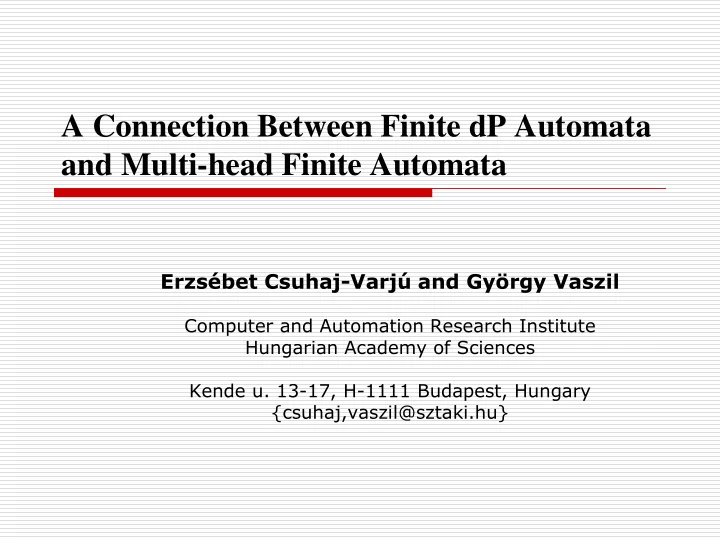

A Connection Between Finite dP Automata and Multi-head Finite Automata Erzsébet Csuhaj - Varjú and György Vaszil Computer and Automation Research Institute Hungarian Academy of Sciences Kende u. 13-17, H-1111 Budapest, Hungary {csuhaj,vaszil@sztaki.hu}
Outline of the talk • P automata • dP automata – distributed system of P automata • Multi-head finite automata • dP automata versus multi-head automata • Conclusions, open problems
P automata Automata-like purely communicating P systems [Csuhaj- Varjú, Vaszil, 2002] Related model: analysing P system [Freund, Oswald, 2002]
Motivation
Expected Results
P automaton
P automaton – the basic variant
A P automaton
The communication rules Symport/antiport rules with promoters and inhibitors The rules are applied in maximally parallel or sequential manner.
Functioning of a P automaton
Functioning of a P automaton - continued
Language of a P automaton
Remark on the language of a P automaton
Classical versus P automata
Classical versus P automata
The power of P automata For linear space computable mapping f: [Csuhaj- Varjú, Ibarra, Vaszil, 2004]
Computational Completeness
Summary on P automata
Distributed (d)P automaton A system of a finite number of P automata • which have their own separate inputs and • which also may communicate with each other by means of special antiport-like rules . [P ăun, Pérez - Jiménez, 2010]
Aims Study • communication complexity • distribution • synchronization • relation to classical models of computing
Distributed P (dP) automaton
A dP automaton c b a A c a b b/a C c P automata communicating with each other and their environment
Configuration of a dP automaton
Functioning
Configuration change
Computation
Acceptance
Language of a dP automaton In this seminal article mapping f perm was used .
Example [P ăun,Pérez - Jiménez, 2011]
Results on the concatenated languages of dP automata [P ăun, Pérez - Jiménez, 2011]
A variant of dP automata
dP automata versus classical automata Finite dP automaton resembles to multi-tape (multi-head) finite automaton
Multi-head finite automaton • Natural extension of a finite automaton • It may have more than one heads reading the same input word , the heads may scan the input symbol and move when the state of the automaton changes. • Acceptance is defined as in the one-head case : an input string is accepted if starting from the beginning of the word with all heads (that never leave the input word), the automaton enters an accepting state. • Analogously to the one-head case, deterministic and non-deterministic, one-way and two-way variants are considered. (If the heads are allowed to move in both directions, the automaton is called two-way, if only from left to right, then one-way.)
Multi-head finite automaton d a b a 3-head finite automaton q [Rabin, Scott, 1964] [Rosenberg, 1966]
Non-deterministic one-way k-head finite automaton (a 1NFA(k)) a a b c 3-head one-way finite automaton movement q in one direction
Non-deterministic two-way k-head finite automaton (a 2NFA(k)) a b a c a 3-head two-way finite automaton movement in q two directions
Configuration of a 2NFA(k)
Computation by a 2NFA(k) Direct change of configurations
Language of a 2NFA(k)
Results on multi-head finite automata L=DSPACE(log(n)) and NL=NSPACE(log(n)) k≥1 k≥2 k≥1
Resemblence to finite dP automata The configurations of the finite dP automaton correspond to the states of the finite multi- head automaton, the input of the multi-head finite automaton corresponds to the (mapping of the) input sequence of a (any) component P automaton .
Strong agreement language of a dP automaton The language contains the words which can be accepted by all components , all of them reading (i.e. having as input) the same multiset sequence during a successful computation.
Weak agreement language of a dP automaton The language consists of all strings which can be accepted by all of the components simultaneously without requiring that the accepted multiset sequences are also the same .
One-way multi-head finite automata versus finite dP automata The weak agreement language of a finite dP automaton (with respect to the mapping f perm ) is equal to the language of a one-way multi-head finite automaton . Theorem
Proof idea finite dP automaton one-way multi-head finite automaton
One-way multi-head finite automata versus finite dP automata The language of any one-way finite multi-head automaton can be obtained as the strong or weak agreement language of a finite dP automaton with respect to the mapping f perm . Theorem
Proof idea one-way multi-head finite automaton finite dP automaton
Two-way multi-head finite automata versus finite dP automata We introduce the notion of a two-way dP automaton and we show how two-way finite dP automata characterize the language family accepted by non-deterministic two-way multi-head finite automata.
Two-way trail It describes that the head never moves to the left of the left endmarker. It guarantees that the head finishes its movement on the last symbol
Two-way trail It identifies the subwords which describe the turn of the direction. It requires that after turning, the same symbols are read in the inverse order as the ones that were read before the turn.
Two-way trails and 2NFA(k) The concept of a two-way trail can be extended to the concept of a two-way multiset trail in an obvious manner.
Two-way dP automaton
Reduction mapping for two-way trails
Languages of two-way dP automata Strong agreement language
Languages of two-way dP automata Weak agreement language
Results Theorem Theorem
Conclusions, Open problems 1. NSPACE(log n) can be characterized by finite dP automata 2. Decidability question concerning multi-head finite automata and their language classes can be examined in the frame of finite dP automata.
References
Recommend
More recommend